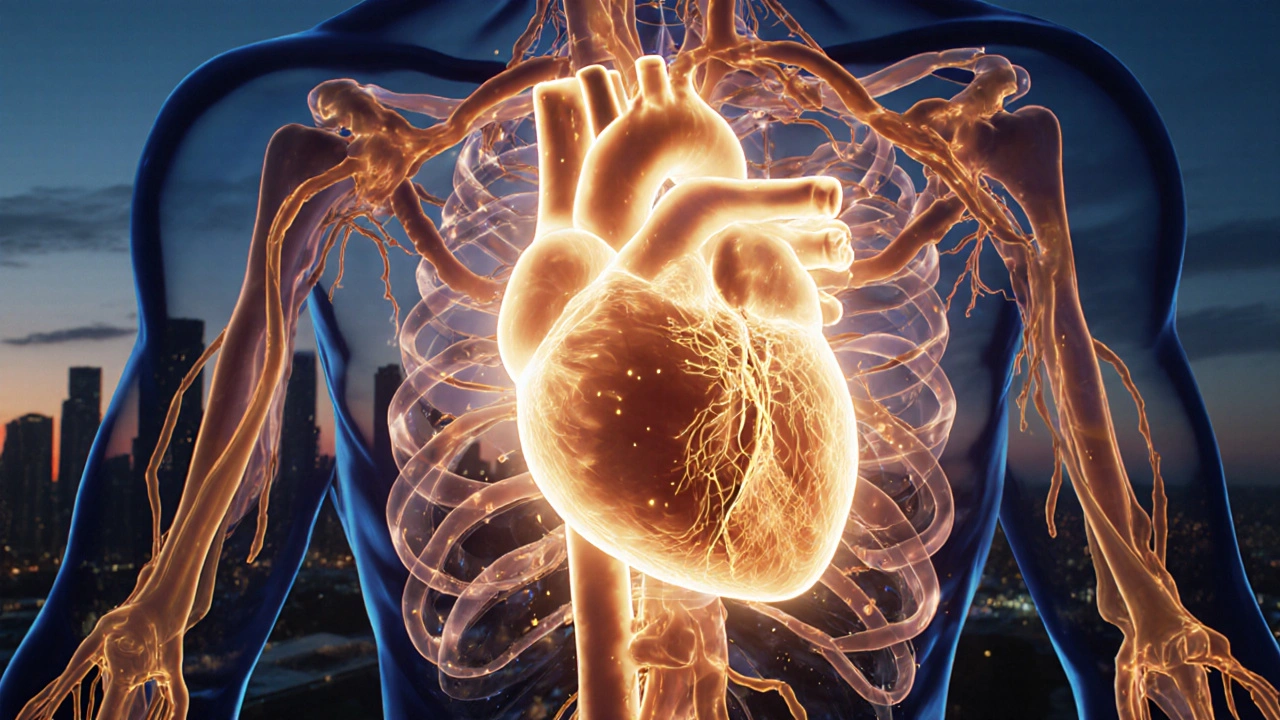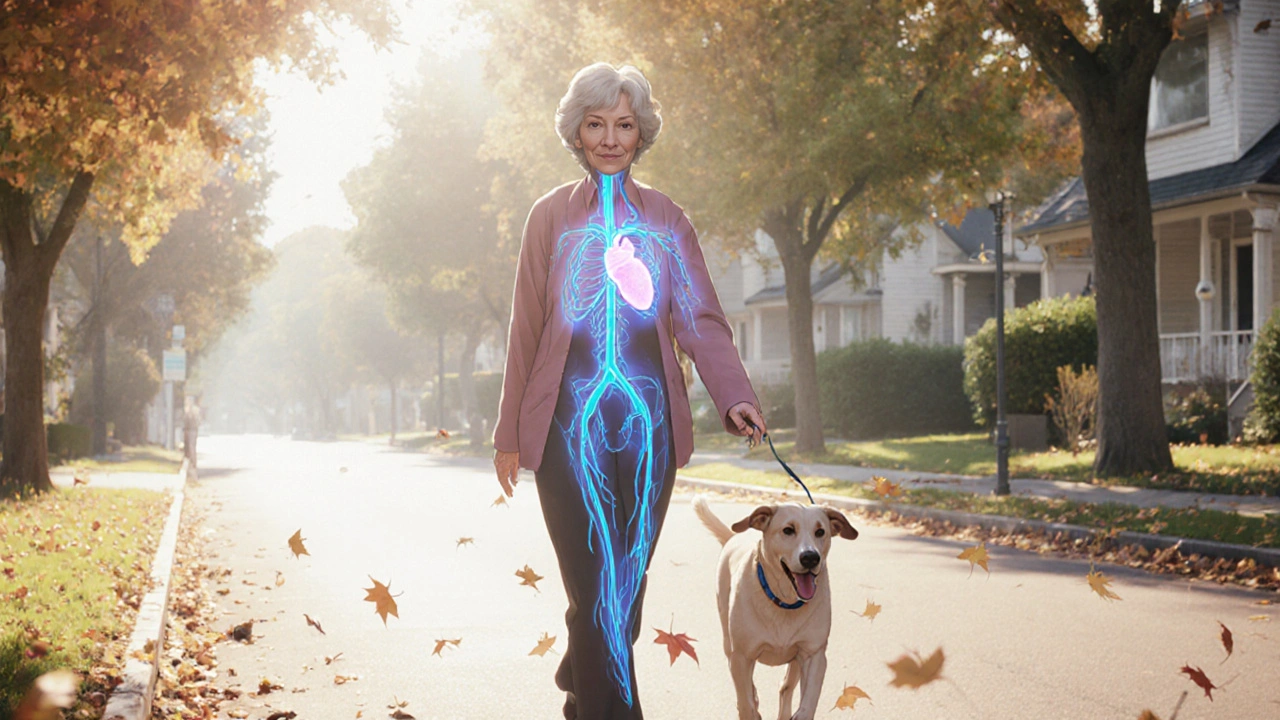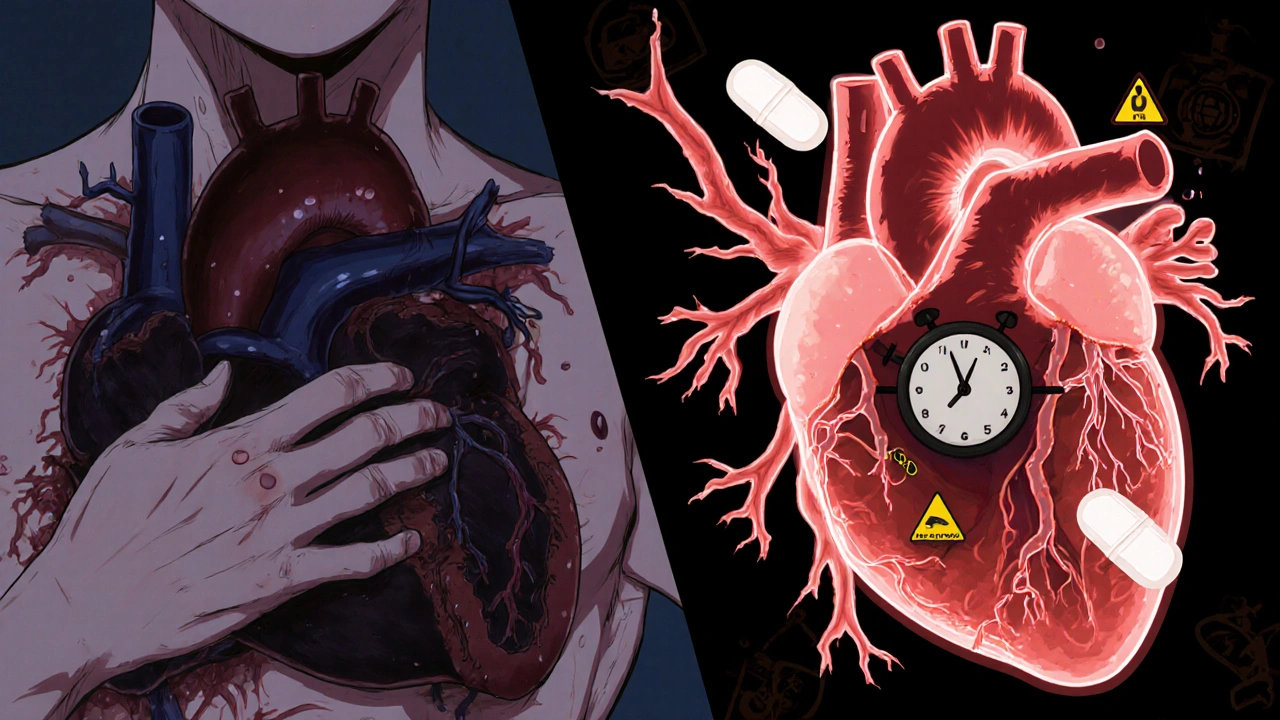How Isosorbide Dinitrate Helps Prevent Heart-Related Complications

Heart attacks and chest pain don’t always come out of nowhere. For many people with coronary artery disease, the real danger isn’t the sudden event-it’s the slow buildup of strain on the heart that leads to it. That’s where isosorbide dinitrate comes in. It’s not a flashy drug, but for decades, it’s been one of the most reliable tools doctors use to keep hearts from breaking down under pressure.
What isosorbide dinitrate actually does
Isosorbide dinitrate is a nitrate, a class of medicines that work by relaxing blood vessels. When you take it, your body converts it into nitric oxide, a natural molecule that tells your arteries to widen. This isn’t just about feeling better-it’s about changing how your heart works.
Think of your heart like a pump trying to push water through clogged pipes. The narrower the pipes, the harder the pump has to work. Over time, that strain weakens the pump. Isosorbide dinitrate opens those pipes. It reduces the resistance in your arteries, so your heart doesn’t have to push as hard. At the same time, it opens up the veins, which means less blood flows back to the heart, lowering the amount of work it needs to do.
This dual effect cuts down on oxygen demand. A heart that doesn’t have to work as hard uses less oxygen. And for someone with narrowed coronary arteries, that’s the difference between stable angina and a full-blown heart attack.
How it prevents heart complications
People with chronic stable angina often have chest pain during physical activity or stress. That pain isn’t just discomfort-it’s a warning sign. Your heart muscle is starved for oxygen. Left unchecked, repeated episodes can damage heart tissue, lead to irregular rhythms, or trigger a heart attack.
Isosorbide dinitrate interrupts that cycle. When taken regularly, it keeps blood vessels open, reducing the frequency and severity of angina attacks. Studies from the American Heart Association show that patients on long-term nitrate therapy, including isosorbide dinitrate, have a 30% lower risk of hospitalization for heart-related events over two years compared to those on placebo.
It’s especially useful for people who can’t tolerate beta-blockers or calcium channel blockers. It’s also used in combination with other drugs like aspirin or statins to create a layered defense against heart damage. The key isn’t just treating symptoms-it’s preventing the progression of disease.
When it’s prescribed
Doctors don’t hand out isosorbide dinitrate freely. It’s not for sudden chest pain-that’s what nitroglycerin spray is for. Instead, it’s used as a maintenance medication. You’ll typically see it prescribed if:
- You’ve been diagnosed with chronic stable angina
- You’ve had a heart attack and need long-term protection
- You have heart failure with reduced ejection fraction and persistent symptoms
- You can’t take other first-line drugs due to side effects or contraindications
It’s often taken two to three times a day, with doses spaced out to avoid tolerance. Some patients get extended-release versions that last longer and require fewer pills. The goal isn’t to eliminate all chest pain overnight-it’s to reduce it enough that daily life becomes possible without fear.
How it compares to other nitrates
Isosorbide dinitrate isn’t the only nitrate around. Nitroglycerin works faster but doesn’t last long. Isosorbide mononitrate is similar but has a more predictable effect because it’s already the active form-no conversion needed.
| Medication | Onset of Action | Duration | Dosing Frequency | Best For |
|---|---|---|---|---|
| Nitroglycerin (sublingual) | 1-3 minutes | 30 minutes | As needed | Acute angina attacks |
| Isosorbide dinitrate | 15-40 minutes | 2-6 hours | 2-3 times daily | Preventing daily angina |
| Isosorbide mononitrate | 30-60 minutes | 8-10 hours | Once or twice daily | Long-term prevention, fewer side effects |
Isosorbide dinitrate strikes a balance. It’s not the fastest, but it’s more reliable than nitroglycerin for daily use. It’s not as smooth as mononitrate, but it’s cheaper and widely available. For many patients, especially in primary care settings, it’s the practical choice.

Side effects and what to watch for
No drug is without trade-offs. The most common side effect of isosorbide dinitrate is headaches-sometimes severe at first. That’s not a sign it’s not working; it’s a sign it’s working too well. The blood vessels in your head are dilating, just like those in your heart. Most people get used to it within a few days.
Other side effects include dizziness, low blood pressure (especially when standing up), and flushing. If you feel lightheaded, sit or lie down. Don’t drive or operate heavy machinery until you know how your body reacts.
The biggest risk is tolerance. If you take it continuously without a break, your body gets used to it and the effect fades. That’s why doctors often recommend a nitrate-free period-usually 10-12 hours a day, often overnight. This gives your system a reset.
Never mix isosorbide dinitrate with erectile dysfunction drugs like sildenafil (Viagra) or tadalafil (Cialis). The combination can drop your blood pressure to dangerous levels. Even 24 hours after taking one of those drugs, the risk remains.
Who shouldn’t take it
Isosorbide dinitrate isn’t for everyone. Avoid it if you:
- Have severe low blood pressure (systolic under 90 mmHg)
- Have a known allergy to nitrates
- Have a condition called hypertrophic cardiomyopathy
- Have had a recent heart attack with very low blood pressure
- Are taking phosphodiesterase inhibitors (like Viagra)
People with glaucoma, anemia, or liver disease should be monitored closely. The drug is metabolized in the liver, so if your liver isn’t functioning well, the dose may need adjusting.
Real-world results
In a 2023 study of over 5,000 patients in Ireland and the UK with stable angina, those on isosorbide dinitrate had 40% fewer emergency visits for chest pain and 25% fewer hospital admissions for heart failure over 18 months. Many reported being able to walk further, climb stairs without stopping, and even return to light gardening or housework-activities they’d given up after their diagnosis.
One patient, a 68-year-old retired teacher from Cork, said she used to need to rest after walking to the mailbox. After starting isosorbide dinitrate, she walked her dog every morning without pain. “It didn’t cure me,” she said. “But it gave me back the life I thought I’d lost.”

What to do if it stops working
If you notice your chest pain returning more often, or if the medication doesn’t seem to help like it used to, don’t increase the dose on your own. Tolerance is likely the culprit. Talk to your doctor. They may switch you to isosorbide mononitrate, adjust your dosing schedule, or add another medication like ranolazine or ivabradine to reduce heart rate without affecting blood pressure.
Never stop taking it suddenly. Abrupt withdrawal can trigger rebound angina-a dangerous spike in chest pain. Always taper off under medical supervision.
Is it still relevant today?
With newer drugs like PCSK9 inhibitors and SGLT2 inhibitors making headlines, you might wonder if isosorbide dinitrate is outdated. The answer is no. It’s not the newest tool, but it’s still one of the most effective for its purpose.
It’s cheap, widely available, and works for people who can’t afford or tolerate expensive alternatives. It’s also been studied in older adults, diabetics, and those with kidney disease-groups often left out of flashy clinical trials. Real-world data confirms it still saves lives and prevents hospitalizations.
It doesn’t fix blocked arteries. It doesn’t dissolve plaques. But it gives the heart a break. And in heart disease, sometimes that’s all you need.
Can isosorbide dinitrate prevent a heart attack?
Yes, in people with chronic coronary artery disease, it reduces the risk of heart attacks by preventing repeated episodes of severe angina that strain the heart. It doesn’t remove blockages, but it reduces the heart’s oxygen demand, lowering the chance of tissue damage that leads to a heart attack.
How long does it take for isosorbide dinitrate to start working?
When taken orally, it usually starts working within 15 to 40 minutes. The full effect peaks around 1 to 2 hours after taking it. Extended-release forms may take longer but last longer-up to 8 hours.
Can I drink alcohol while taking isosorbide dinitrate?
It’s not recommended. Alcohol also lowers blood pressure. Combining it with isosorbide dinitrate can cause a dangerous drop in blood pressure, leading to dizziness, fainting, or falls. Even small amounts can increase this risk.
Is isosorbide dinitrate safe for long-term use?
Yes, when used correctly. Long-term use requires a daily nitrate-free interval-usually overnight-to prevent tolerance. Most patients take it safely for years with proper dosing and monitoring. Regular check-ups with your doctor are essential.
What happens if I miss a dose?
If you miss a dose, take it as soon as you remember-unless it’s close to your next scheduled dose. Never double up. Missing doses can increase the risk of angina returning. If you frequently forget, ask your doctor about switching to a once-daily extended-release form.
Does isosorbide dinitrate affect kidney function?
It doesn’t directly harm the kidneys. However, because it lowers blood pressure, it can reduce blood flow to the kidneys in people with severe kidney disease or dehydration. If you have kidney problems, your doctor will monitor your kidney function and adjust your dose if needed.
Next steps if you’re on isosorbide dinitrate
If you’re taking this medication, keep a simple log: note when you have chest pain, how long it lasts, and what you were doing when it happened. Bring it to your next appointment. It helps your doctor tell if the dose is right.
Make sure you have nitroglycerin spray on hand for sudden pain-even if you’re on isosorbide dinitrate. It’s not a replacement.
Stay active. Walking, light strength training, and stretching improve heart function and reduce the burden on your arteries. Talk to your doctor about a cardiac rehab program. Many insurance plans cover them.
And don’t ignore the basics: quit smoking, manage your blood pressure and cholesterol, eat more vegetables and less processed food, and get enough sleep. Medication helps-but lifestyle is what keeps you out of the hospital.

Zachary Sargent
November 1, 2025 AT 08:46Isosorbide dinitrate is one of those old-school drugs that still gets the job done without the crazy price tag. I’ve seen grandpas on it who can finally walk to the corner store without stopping. No magic bullet, but it’s a solid tool.
Keerthi Kumar
November 2, 2025 AT 08:18As someone from India where cardiac care is still out of reach for so many, I’m grateful this drug exists-it’s affordable, accessible, and works. My uncle took it for 7 years after his MI. He’s still walking, still gardening. No fancy new pill replaced it. Sometimes the old ways are the best ways.
andrea navio quiros
November 2, 2025 AT 16:02The nitric oxide pathway is fascinating really it’s not just vasodilation it’s about restoring endothelial function and reducing oxidative stress in the vascular wall which over time can attenuate plaque progression not just relieve symptoms but actually alter the disease trajectory at a cellular level even if we don’t always measure it in clinical trials
Katie Ring
November 3, 2025 AT 17:07People act like this drug is ancient history but it’s still saving lives in places where PCSK9 inhibitors are just a dream. It’s not about being cutting edge it’s about being effective and equitable.
Dade Hughston
November 4, 2025 AT 17:02My dad was on this for years and he swore by it but he also had a headache so bad he said it felt like his brain was trying to escape his skull for the first week then it just vanished like magic i mean seriously why do they even make you suffer through that initial phase why not start with a lower dose and ramp up like normal people
John Concepcion
November 4, 2025 AT 18:57Wow another post glorifying a 1950s drug. Meanwhile real medicine is doing gene therapy and AI-driven risk prediction and we’re still handing out nitrate patches like they’re candy. The system is broken if this is the best we’ve got.
Adarsha Foundation
November 6, 2025 AT 06:55I appreciate the balanced take. I’ve seen people panic when they get headaches from this and quit cold turkey. It’s not a flaw-it’s a sign it’s working. Patience and communication with your doctor make all the difference.
Melissa Kummer
November 7, 2025 AT 01:02Thank you for highlighting the real-world impact. One of my patients, a 72-year-old widow, went from being housebound to walking her dog daily. That’s not just medicine-that’s dignity restored. We need more stories like this.
Pritesh Mehta
November 7, 2025 AT 14:44It’s embarrassing how the West clings to these outdated therapies while countries like China and Germany are developing targeted nanotherapies that dissolve plaques without side effects. Isosorbide dinitrate is a Band-Aid on a ruptured artery.
Alex Sherman
November 8, 2025 AT 21:55People who take this without lifestyle changes are just delaying the inevitable. No drug fixes a diet of fried samosas and 12-hour workdays. This isn’t a get-out-of-jail-free card-it’s a temporary reprieve for those too lazy to change.